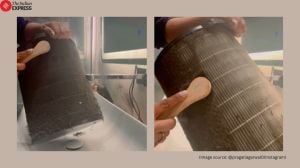Eight districts in the last stage of eliminating Elephantiasis, says DHS
According to the Directorate of Health Services (DHS), since 2020-’21, new cases of elephantiasis have either been non-existent or minimal in Jalgaon, Wardha, Sindhudurg, Akola, Amravati, Latur, Osmanabad, Solapur, Thane and Yavatmal .
 In accordance with the protocols, it is crucial to strictly adhere to specific time frames during the day. The state has 34-night clinics to do the testing. “ (Express File Photo)
In accordance with the protocols, it is crucial to strictly adhere to specific time frames during the day. The state has 34-night clinics to do the testing. “ (Express File Photo) EIGHT DISTRICTS in Maharashtra are nearing the target of eliminating Elephantiasis, a disfiguring ailment transmitted by mosquito bites that lead to disabilities. The state bears a substantial burden with over 30,000 confirmed cases.
According to the Directorate of Health Services (DHS), since 2020-’21, new cases of elephantiasis have either been non-existent or minimal in Jalgaon, Wardha, Sindhudurg, Akola, Amravati, Latur, Osmanabad, Solapur, Thane and Yavatmal . As a result, these districts have been designated as being in the last stage of eliminating elephantiasis and would receive a certification by the World Health Organisation (WHO) soon.
“These districts have scarcely reported any new cases since 2020. The current patients were previously identified. This positions these areas in the conclusive phase of the elimination process, making them eligible for the WHO’s elimination certificate,” stated a senior health official from the DHS.
Elephantiasis, also known as Lymphatic Filariasis, results from parasitic worms transmitted by mosquitoes, infiltrating the lymphatic system and disrupting fluid balance, causing extensive swelling—lymphedema. The impact extends beyond limbs, affecting immune function and leading to swelling in various body parts like the face, neck and scrotal tissues. “Though non-lethal, the aftermath is dire, as disfigurement traps individuals in poverty and isolation, exacting a profound social and economic toll,” said Dr Sagar Patil, district malaria officer, Palghar. Under the public health department’s scheme, individuals eligible in regions impacted by the disease are provided with a blend of options: a duo of diethylcarbamazine (DEC) and albendazole, or a trio including Ivermectin, DEC, and Albendazole.
In severe cases where lymphedema leads to extreme disfigurement and functional impairment, surgical options might be considered. “Since 2020, we have conducted around 4,200 surgeries which have helped to reduce the excess tissue and improve the appearance and function of the affected body parts,” said an officer from DHS. Individuals of various age groups fall prey to the infection.
Though the infection might be contracted in childhood, its apparent symptoms surface later in life, as outlined by the WHO. Consequently, each year, adhering to WHO’s recommendations, the district undertakes a process of random screening, specifically targeting children. Blood tests are utilised to identify these minuscule, thread-like worms.
In accordance with the protocols, it is crucial to strictly adhere to specific time frames during the day. The state has 34-night clinics to do the testing. “We gather blood samples exclusively during the night, aligning with the feeding patterns of vector insects. A dedicated healthcare team is in charge of this procedure,” he added.







